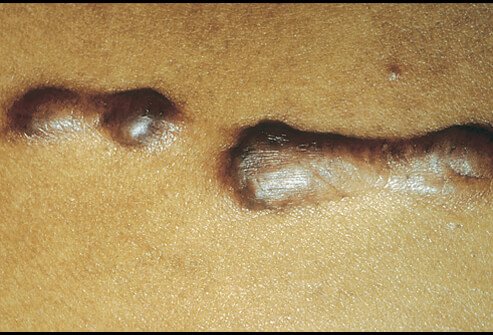Keloid
Picture of Keloid

Keloid: A scar that doesn't know when to stop. When the skin is injured, cells grow back to fill in the gap. Normally, they "know" when the scar tissue is level with the skin, at which point the cells stop multiplying. When the cells continue reproducing, the result is an overgrown (hypertrophic) scar or a keloid—a tough, heaped-up scar that rises abruptly above the rest of the skin. It is irregularly shaped and tends to enlarge progressively.
In other words, keloids are due to an excessive response to trauma, such as a cut to the skin. In creating a normal scar, connective tissue in the skin is repaired by the formation of collagen. This occurs in the dermis (the layer of skin just below the epidermis, the outer layer of skin). Keloids arise when too much collagen forms in the dermis during the repair of connective tissue.
To develop keloids, a person must be susceptible to keloid formation. This susceptibility is clearly genetic. For instance, keloids are known to have occurred in five successive generations within a single family.
People of African or Asian descent are more likely to develop keloids than people with lighter skin. These populations tend to have keloid susceptibility genes. This tendency to form keloids is important when someone of African or Asian descent considers elective plastic surgery, as the surgery can cause more trouble than it cures.
The dense, tumor-like scar was called a "keloid" ("cheloïde" in French) in 1835 by the dermatologist Jean-Louis Albert. However, the word "keloid" was already in use in France as early as 1817, according to the Nouveau Petit Robert Dictionnaire. The origin of the term "keloid" is not entirely certain. The Petit Robert attributes it to the Greek word "chele," meaning in French "pince" and in English "a talon, claw, or hoof." Other authorities, such as Dorland's Illustrated Medical Dictionary, attribute "keloid" to the Greek "kelis," meaning "blemish," or to the Greek "kele," meaning "a rupture."
To learn more, see Keloid.
Image Source: Color Atlas & Synopsis of Pediatric Dermatology
Kay Shou-Mei Kane, Jen Bissonette Ryder, Richard Allen Johnson, Howard P. Baden, Alexander Stratigos
Copyright 2002 by The McGraw-Hill Companies. All rights reserved.
Source: MedTerms™ Medical Dictionary by MedicineNet, Inc.

